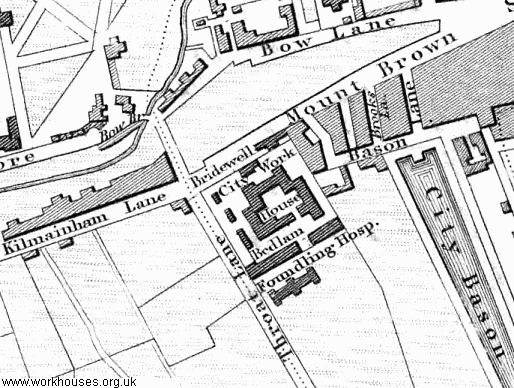The Admission and Discharge Registers for three of the four Dublin Workhouses have just appeared on www.findmypast.ie. The registers are for the North and South Dublin Union and Rathdown Union Workhouse, and date from 1840 to 1919. As many Dublin families are likely to have encountered the Workhouse during their lifetimes these registers are a huge resource for researching Dublin city and county ancestors.
Workhouses in Ireland were established under the Act for the Effectual Relief of the Destitute Poor in Ireland, which was passed in 1838. Similar legislation was passed in England and Wales in 1834 on which the Irish system was based. The “Poor Law Act” divided the island of Ireland into Unions, each Union would be governed by a Board of Guardians and each Union would have a workhouse from which to administer relief to the poor and destitute of that Union. The relief would be financed by a tax on local property. The valuation carried out to determine the rate of tax, which was levied for the support of the Poor Law Union is known as Griffith’s Valuation, another vital resource for researching Irish genealogy.
The North and South Dublin Unions were formally declared on 6th June 1839, however both institutions had already been established and operating as Houses of Industry as well as a Foundling Hospital, Asylums and Fever Hospitals on the same sites from the early 18th century. The workhouse registers that have been published for both workhouses commence in 1840.
The North and South Dublin Workhouses provided more than just refuge for the absolute destitute of the city. Many of the inmates were seeking medical or maternity care and the admission and discharge registers will usually state the medical complaint of the inmate, indicating the reason behind their admission.
The Dublin workhouse registers generally record the name, age, marital status, address and occupation of the inmate on admission. There are often details of the next of kin, such as the parents of a child or the husband of a female inmate and then the details of their discharge. Children born outside of marriage were often born in the Dublin Workhouses and the name of the mother may have been noted in the register. Of course entire families could have been admitted to the workhouse when they fell on particularly hard times and should all now be found in the admission registers.
Families or individuals who are missing from the 1901 and 1911 census of Ireland may have been in the workhouse on the night of the census. With the release of these records you now have the chance to check for evidence of their admission and discharge. The Workhouse registers will be even more effective for individuals admitted prior to the start of civil registration, which commenced in Ireland in 1864. For example, on 21st September 1840 a Mary Woods was admitted to the Workhouse. She was a 64 year old widow who worked as a servant. She was described as healthy and clean (her fellow inmates were described as ragged and infirm). Her condition on entry suggests that she was not in ill health, but unable to support herself. Although she was a widow she gave the name of her husband, John. This record identifies a woman who was born ca. 1776, as well as the name of her husband, who was deceased prior to 1840. These earlier registers may help to document individuals who were born in the 18th century and died in Dublin prior to 1864.
For anyone researching families who lived in Dublin City or South County Dublin these registers are certainly worth investigating.
Sources:
www.workhouses.org.uk

